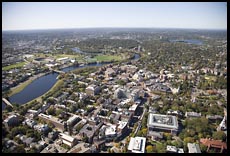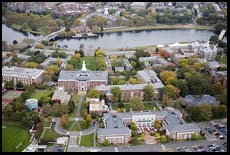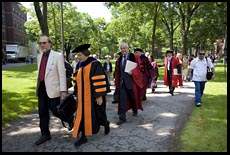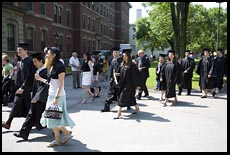
Higher Education?
a review by Philip Greenspun; April 2011
Site Home : Book Reviews : One Review

|
Higher Education?a review by Philip Greenspun; April 2011
Site Home : Book Reviews : One Review |
Higher
Education?: How Colleges Are Wasting Our Money and Failing Our
Kids---and What We Can Do About It is a collaboration between
Andrew Hacker, a political science professor at Queens College, and
Claudia Dreifus, a science journalist for the New York Times.
The first chapter starts out very strong with some awesome calculations. A professor at Kenyon College earns $242 per hour (based on actual classroom and office hours); his or her counterpart at Yale? $820 per hour. "We readily acknowledge that [professors] do something outside their classroom and office hours. But the great bulk of it is less real than contrived: committees, department meetings, faculty senates, and yes, what they call their research, the utility of which we question in a later chapter."
The authors point out that professors often aren't on campus at all: "At Harvard, even untenured asssistant professors get a fully paid year to complete a promotion-worthy book. Thus in a recent year, of its history department's six assistant professors, only two were on hand to teach classes. In Harvard's department of philosophy that same year, almost half of its full-time faculty were away on sabbaticals. Of course it was the students who paid. Many of their undergraduate courses were canceled or given by one-year visitors unfamiliar with the byways of the university."
"At the end of the day, this strange little world [of academia] often alienates the genuinely smart and idealistic. Many of the best people find it intolerable, clearing the path for careerists."
"In 1976, for every 1,000 students, there were 32 adults holding non-faculty positions. By 2007 ... there were 63 such people for every 1,000 students. ... Since 1976, [the number of higher-level administrators such as admissions officers and assistant deans] has more than tripled."
Given that an adjunct earns an average of $3,000 per class taught, a tiny fraction of what it costs to employ a tenure-track professor, including pension and other benefits, it seems obvious why colleges and universities would seek to employ them and, indeed, that may explain why for-profit universities do so. Hacker and Dreifus, however, point out that traditional American colleges and universities are among the world's least efficient enterprises, spending lavishly in all kinds of areas. Why would they be so interested in cheap labor in this one area?
"Even smaller colleges now want to talk about how their professors are publishing and giving conference papers. With so many faculty taking time away from teaching, more visitors and part-timers were brought in to ensure that necessary courses were given. In a similar quest for status, colleges recast themselves as universities ... In consequence, fewer professors had the time--indeed, the desire--to teach the undergraduate classes that had been their usual load. Adjuncts took their place, especially at the introductory level..
What are the chances that a Ph.D. will end up with a coveted tenure-track job or be doomed to a lifetime of adjunct vagabonding? "Between 2005 and 2007, American universities awarded 101,009 doctoral degrees. The number of new assistant professorships created in those years: 15,820." [The reviewer notes that the authors may not have properly accounted for PhDs in Education and Clinical Psychology, where teaching and research are seldom a goal. The Survey of Earned Doctorates in 2009, indicates that approximately 6500 Education doctorates are awarded each year. Most of those are sought by public school employees anxious for the guaranteed boost in salary and pension that such a degree confers. How come the authors and editors of this $26 book couldn't grab the report off the Web as I did?]
The authors cite some anecdotal data that adjuncting is a common fate for female PhDs who've had children: "Adjuncting is where the so-called Mommy Track is," they quote one researcher.

The authors identify the 12 most sought-after undergraduate institutions: the Ivy League plus Stanford, Duke, Amherst, and Williams. Then they try to figure out if these schools were worth the high cost, at least for those determined to add additional credentials. So they tried to figure out what the chances were for getting into Harvard Law School conditional on having attended various undergraduate institutions and managed to get some data under the table. Harvard Law "reserves close to half its places for students from twelve selective colleges. ... The other half of Harvard Law's classes--the 1,929 applicants from 298 other schools--present a rather different picture." Basically, if your kid can't get into an Ivy League school, he may be just as well off at a state university as at a very expensive and supposedly elite liberal arts college.

Th authors visit Harvard (supposedly $126,000/year spent on each student) and Oregon State ($30,000/year budget per student). The experience of undergraduates in the classroom was remarkably similar and at both schools surveyed students felt that the professors were doing the bare minimum so that they could get back to their research. The authors also found that a handful of great teachers were able to transcend the system and, even in large classes, inspire students. I.e., a student may spend $250,000 to buy into a deeply flawed system that only occasionally and through random variation produces a good result for one course in one semester.
The authors use this chapter to challenge a provost's statement that "You can't possibly be a good teacher unless you're interested in sharing what you've learned, both through research and publication. ... the more we stress research, the better our teaching will be." The book says that "factually, it's wrong", but cite mostly anecdotal evidence that research is irrelevant. The authors do cite a National Survey of Student Engagement in which students rated professors on "helpfulness" and "availability". Research universities did very poorly; small and obscure colleges did well. The Princeton Review also surveys students, probably less systematically. Harvard undergrads give their professors C- on "classroom performance" and D on "outside-of-class availability". Upset by the evidence that it was delivering a poor quality product, Harvard appointed a committee: "All but one of its members held endowed chairs ... No junior faculty, no teaching assistants, and notably no students were invited to serve."
The authors offer practical advice for improving teaching:

"Until the mid-1960s, there was essentially an even balance between vocational training and the liberal arts. ... business programs have made the most striking gains since 1968, followed by health fields. Psychology is the traditional liberal arts field that has grown in popularity. ... The biggest losers have been the social sciences, humanities, and the physical sciences. English now attracts only half the majors it did in the mid-1960s... Physical science majors are down by 60 percent. And relative to total enrollments only a quarter as many students are choosing mathematics.
The authors, one a political science professor at Queens College and the other a science journalist for the New York Times, suggest that vocational majors be eliminated: "we deem it a huge mistake to squander years that could and should be devoted to enriching young minds. ... vocational programs are chosen while students are applying from high school. ... there's one thing [17-year-olds] don't know, and there is no way they can at their age. It is what the world of adult careers is actually like."
The percentage of engineering majors has fallen from 5.9 to 5.4 between 1968 and 2008 (business rose from 12.8 percent to 21.5 percent). The authors would like to see engineering pushed out to grad-school only: "A study conducted at the University of Pittsburgh found that of freshmen who embark on engineering, over half never leave with a degree. ... [The Princetown Review's] 2010 edition found that the colleges most often cited for abysmal teaching were schools of engineering. Among the worst offenders were Stevens Institute Rensselaer, Georgia Tech, Illinois Institute of Technology, along with the fabled Cal Tech..." [I was pleased to see that MIT did not make the list, though Rensselaer is headed by Shirley Ann Jackson, an MIT graduate notable for being one of America's highest-paid university presidents (page 40: $1.6M in 2008 plus another $1.4M for serving on six corporate boards while Rensselaer "happens to hold an unimpressive 21st place in the U.S. News and World Report engineering ranks").]
The immensely popular undergraduate business major comes in for ridicule because the students practice making big strategic decisions under the guidance of PhDs in business who've never worked in a for-profit enterprise. Then the youngsters graduate into jobs where the last thing that their employer would ever ask them to do is make a big strategic decision.

The authors note the persistent similarity of tuition prices across a broad range of schools and ask how this can possibly be a coincidence. They also allude to the Sherman Antitrust Act, but without mentioning the U.S. Justice Department's 1989 (during the reign of King Bush I) prosecution of the Ivy League, plus a short list of competitors, including MIT. The price-fixing case resulted in some settlements, a 1992 verdict against MIT in Federal District Court, and ultimately a successful appeal by MIT (press release with some background). In addition to having fixed advertised tuition prices, the schools had been meeting since the 1950s to fix financial aid awards to particular students who'd been admitted to multiple colleges, agreeing not to cheat on the cartel by offering better deals to students they wanted to attract. The fact that the authors did not mention this landmark case is a disturbing lapse of scholarship.
Aside from price fixing, how to account for the current high cost of college? The authors go through the perverse incentives that drive colleges to keep advertised tuition prices high. Because there is no way for anyone to evaluate the actual quality of the product, people assume that a high-priced college must be high quality. What about actual costs? Higher Education? notes that "academic salaries had been rising at a much faster clip than in other occupations. Since the mid-1980s, as we have noted, full professors' pay at Stanford has increased 58 percent in constant dollars; the University of North Carolina they are up 56 percent; and at Duke 65 percent." The expanding administration and the rising compensation of top executives are the second big factor, according to the authors. Varsity sports collectively ran a deficit of $3.6 billion.
The authors aren't economists, but they do finally correlate the availability of loans with the inflation in prices: "At the urban University of Hartford, which serves many blue-collar and minority students,f ully 78 percent graduate with debt, with a before-interest average of almost $39,000. Mississippi's Tougaloo College, a historically black school in the nation's poorest region, has 80 percent of its graduates holding loans, averaging $41,000. ... Due to the loan industry's lobbying, Congress obligingly decreed that student loans can never be discharged by bankruptcy. Higher education, which cheered on this borrowing to ensure its own cash flow, has created its counterpart of the housing bubble." [See this June 2010 article on the subject.]
What can consumers do in the face of these prices? The authors are champions of a liberal arts education and recommend a few public honors programs within larger state universities, e.g., at Arizona State University and University of Mississippi. The authors also like the regional campuses of big state schools: "We want to reiterate that you can get a very good liberal arts degree on these campuses. We've visited several, where we sat in on classes and conversed with faculty and undergraduates. ... the students are as bright and academically committed as any, and second, the regional professors are among the most dedicated we've met."

"I can be fired for any reason, except incompetence," is how a Physics professor friend describes tenure. What percentage of his fellow academics enjoy the same protection? Between 70 and 77 percent, according to the authors: "tenure creates an inverted pyramid, with safeguarded senior professors far outnumbering their junior colleagues ... At Stanford University, only 16 percent of its payroll dollars are left for lecturers and assistant professors. ... Thus in 2009 and 2010, when California's university system faced financial shortfalls, it was instructors, adjuncts, and graduate assistants whose jobs were cut. ... 'Our priority is regular faculty who have tenure and need to be paid' [said the vice chancellor] So they get first call on whatever funds are available, regardless of their contribution to the curriculum."
Hacker and Dreifus point out that the original purpose of tenure, protecting researchers whose conclusions might be politically unpopular, doesn't apply to most modern academics, whose specialities are too obscure to be relevant. When tenure is invoked as protection against dismissal, the dispute almost never involves "acts of speech or writing [while] teaching or research[ing] in the fields where the professors had accredited competence." E.g., an engineering professor got fired for seeking a vote of no confidence against the university president. [Sami Al-Arian was fired from University of South Florida, despite tenure in computer engineering, because of his activities on behalf of Palestine Islamic Jihad.]
Ward Churchill is given a few pages. He achieved notoriety after 9/11 by referring to those killed in the World Trade Center as "little Eichmanns". The University of Colorado then tried to get rid of him on the grounds that he had plagiarized some of his writings, fabricated sources, and had a book published under an assumed name so that he could then reference that book to bolster his own research conclusions. A jury did not believe the university, but a variety of judges supported the university's power to fire him. The authors point out that "At the University of Colorado, investigations of faculty research have been extremely rare. While there is a 'standing committee' for that purpose, in the sixteen years from 1989 to 2005, only five cases had been referred to it, and in four, the decision was to take no action."
The authors reach back to the McCarthy era and find that professors with tenure were equally likely to be fired as professors without tenure: "so tenure isn't a protection when it's really needed."
The authors decry the stasis that results from tenure. "Tenure might cause fewer problems if professors who have it were as mobile as other Americans. But once they get the award, most hunker in and never leave. At three colleges we sampled--Colby, Middlebury, and Reed--fully two-thirds of their faculties had been there for at least twenty years, and it seemed clear that most of them would be remaining until they decide to retire." [Earlier in the book, the authors note that there is no mandatory retirement age and a professor may choose to work at his or her tenured salary until death.] "The principal reason they stay is that few of them receive overtures from other colleges. After all, once they get tenure, they no longer have to worry about gaining or maintaining national reputations." This has a particularly pernicious effect on cherished dreams of sex and race equality; the ancient unproductive tenured professors cluttering the payroll tend to be undesired white males. Until they voluntarily leave, there is literally no room for the women and "people of color" being sought by university administrators.
The process of trying to attain tenure stifles research, according to the professors interviewed by the authors. Junior academics must shape their work to appeal to senior colleagues. Students interviewed were uniformly negative on the subject of tenure, having far too much direct familiarity with incompetence.
The authors propose that tenure be replaced with five- or seven-year contracts and cite some good schools that function this way, e.g., Hampshire College and Evergreen State in Washington. The authors have missed the elephant in the room: for-profit colleges, none of which (as far as I know) offer tenure.

The chapter opens with a paragraph about MIT garbing "fifty-six players in cardinal and black". Where are the fact checkers at the New York Times books? The MIT colors are cardinal and gray. A quick Google Images search shows a bunch of padded-out engineers in cardinal and gray uniforms. "The team is supervised by eight salaried coaches" but attracts just 683 spectators at a typical home game.
"Mack Brown, who direct's Texas's football program, gets $5 million annually... An NCAA study found that half its coaches are paid at least $252,000, over twice the salary of professors at most institutions. ... The overwhelming majority of those 17,917 teams in all sports and schools end up losing money. In the top football division, which can count on strong ticket sales, 113 of its 118 teams still run a deficit."
The traditional explanation is that football may be profitable by virtue of generating a lot of alumni contributions (maybe not at MIT!). Surely it can't be the case that university administrators all over the country are dumb enough to continue doing something financially irrational? The authors have reviewed some research by economists finding that donations rise by 7 percent "if a school attains a football bowl slot or basketball's Final Four play-offs. ... Needless to say, the vast majority of teams never get nearly that far, including those that invest heavily in hope of reaching those summits." In short, university administrators really are that dumb.

The authors cover the extensive and familiar efforts wealthy colleges make to attract and enroll students in favored minority groups, such as black and Hispanic, but also include a section on "The Asian Arrival". In 1980 Harvard and Penn had a 5:100 ratio of Asians to whites; it is now 30:100. MIT has gone from 7:100 to 80:100. The academic inferiority of whites is covered in painful detail: "In every income bracket, Asian students surpassed whites." This has motivated college administrators to step up their race discrimination programs: "24 percent of [Asians at highly selective schools] were admitted. But had a 'color-blind' method been used, 32 percent would have been given places." The public universities are prohibited by law from openly discriminating on the basis of race: "Asians now outnumber Caucasians at the University of California's Berkeley, Los Angeles, San Diego, and Irvine branches. ... whites [outnumber Asians] by a factor of four to one in the state's college-age cohort. The simple fact is that whites, even in better-off families, aren't doing as well in California's high schools."
There are 127 women for every 100 men in college and 133 women for every 100 male college graduates. There are many fewer places for men at elite schools, e.g., in 1970 Dartmouth hosted 3,270 men compared to 1,982 today. College administrators are now promulgating separate and easier admissions criteria for men so as to get closer to a 50-50 ratio, though there has been some legal backlash against sex discrimination by public universities. Using family income data from the Educational Testing Service, the authors conclude that boys can do well if they're from well-off families, but in lower income homes it is the girls who stick with the books. Being from a rich family is no guarantee of academic achievement, however: "A Brookings Institution study ... found that close to half--47 percent--of children who were raised in the top economic quintile do not end up with bachelor's degrees."

The authors cite studies that found the Democrats outnumbered Republicans on elite college faculties by 9:1. Among sociologists it was nearly 28:1. Economics was the most balanced, "with a three-to-one Democratic edge". The authors don't explore whether this explains the trillions of dollars of federal and state government subsidies of higher education over the decades. It doesn't appear to make much sense to take money from middle-class taxpayers and hand it to college administrators earning more than $1 million per year or even to the students, who will earn above-average wages by virtue of the credentials that they attain. However, if the college education process itself creates voters who will be in favor of bigger and more powerful government, and less opposed to higher taxes, it might make political sense.
The authors cite studies from the Pew Research Center, which found that, compared to high school graduates, college graduates were more likely (67:43) to be in favor of abortion and more likely (58:30) to believe that homosexuality was "innate" rather than a choice. The authors don't say so explicitly, but it seems that the Pew studies were not longitudinal, i.e., they weren't asking the same people these questions four years later. So there could be a lot of sample bias in that young people who are in favor of abortion are more likely to choose to attend college.
Personal story: I asked some union electricians (high school grads) here in Massachusetts why they had not supported the Democrats in 2008. After all, they were exactly the kind of working-class folks that Obama was promising to redistribute wealth to. It turned out that they believed that the Democrats were going to raise taxes on the wealthy, but they didn't think that they would personally see any of the benefits. They thought that the money would go to people collecting welfare, to government employees, etc. Since the government employs a disproportionate number of workers with college degrees, e.g., teachers, it may simply be that college graduates support a bigger government because they have a realistic chance of recovering some of money paid in higher taxes.
The authors visit Florida Gulf Coast University, which must educate students on a budget of $5,081 per year. Students at the school use computer-based self-paced software to learn the material. Papers may be graded by contractors ($25 per student per semester) in other states connected via Internet. Cheating and plagiarism are detected by similarity-checking programs. It might not be the education that every American deserves, but it is the education that Americans can afford and the authors recognize that this will be the future of higher education for all but a small fraction of America's young people. As liberal arts traditionalists, they're ambivalent about it, but ultimately do not find that the technology-aided system at Florida Gulf Coast is worse for students than the system of heavily worked and lightly paid adjuncts that prevails at similarly funded schools.
In their years of traveling, researching this book, and sitting in on classes, the authors found ten schools that they'd be willing to send their own 18-year-old to:
In the last chapter, the authors circle back to chastising schools for concentrating on non-educational activities such as administration or athletics. They suggest eliminating a lot of vocational majors so as to force students to study liberal arts and "become more thoughtful and interesting human beings." Universities should eliminate tenure, end paid sabbaticals (so that professors would have to stay on campus and teach!).
Some of the authors' suggestions would not clearly improve learning, e.g., "end exploitation of adjuncts". The authors believe that the labor market has failed and adjuncts should receive higher salaries as well as health insurance and other benefits. In fact, if adjuncts were paid more students would get hit with increased tuition and therefore loan expenses, contrary to the authors' earlier recommendation that colleges price themselves so that students don't need loans. More consistently, the authors recommend that university presidents give up their $1+ million salaries, pointing out that "the head of the Food and Drug Administration puts in a full day for $199,700".
Those $1 million/year administrators would react with horror at the authors' next suggestion: that universities spin off medical schools, research centers and institutes. Certainly this is the point where the reader realizes that none of these ideas have any hope of being implemented. What bureaucrat in his right mind would give up a $2-3 million/year income (from the school plus a few corporate boards) and a $300 million/year revenue stream from a teaching hospital and medical school? What incentive do universities have to do a better job teaching undergraduates? What incentive do tenured professors have to exert themselves? The authors do not cite any except that these are the "right" things to do. So as soon as Jesus Christ is appointed head of a university and a group of Saints constitute the faculty, undergraduates will have a fighting chance to learn something. [An alternative way of asking this question is "If you'd accumulated $40 billion in tax-free cash by doing things the same way for 375 years, would you be motivated to make any changes?"]
I think it is far more likely that a nimble competitor will overtake the legacy universities. Harvard is 350 years older than University of Phoenix and was blessed with, literally, billions of dollars more in capital, but University of Phoenix, starting in 1976, has been making continuous efforts at improvement. Thus far the results may not be impressive, but the newer schools have not been at it very long and, perhaps more importantly, the older schools aren't making any attempt to innovate beyond the techniques developed at University of Bologna in 1088 (see "Universities and Economic Growth"). It shouldn't be that tough to compete with legacy enterprises that are utterly indifferent to results and product quality. A great example of this is Olin College of Engineering in Needham, Massachusetts. The school began operation in 2000 and, by abandoning traditional methods of lecture-and-homework, has already overtaken most of the legacy universities on a variety of measures (see various rankings).
Unlike the public K-12 school system, colleges and universities operate in a competitive environment for students. As the United States population grows to its forecast 600 million in the year 2100, we should expect to see enrollment at the effective schools grow while enrollment at the ineffective schools stays constant or shrinks. This seems like a much more likely outcome than the ineffective schools suddenly developing a passion for undergraduate education.